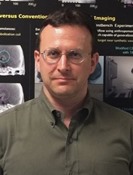A Dual-Energy Approach for Visualizing AGuIX Nanoparticle Uptake in On-Treatment KV-CBCT
M Jacobson1*, T Harris1, S Bennett1, M Myronakis1, I Ozoemelam51, O Tillement2, F Lux2, A Sudhyadhom1, R Berbeco1, (1) Brigham and Women's Hospital, Dana-Farber Cancer Institute, and Harvard Medical School, Boston, MA (2) Institut Lumiere Matiere, University Lyon 1
Presentations
WE-C1000-IePD-F1-2 (Wednesday, 7/13/2022) 10:00 AM - 10:30 AM [Eastern Time (GMT-4)]
Exhibit Hall | Forum 1
Purpose: Radiation dose amplification with nanoparticles can increase cancer cell death without increased toxicity risk. AGuIX nanoparticles, incorporating gadolinium atoms, are under clinical investigation at several centers for MR-guided radiotherapy. Since MR imaging is not readily available in all treatment centers, however, a method to visualize AGuIX using conventional on-treatment kV-CBCT would be beneficial. In this study, we investigate the potential of an iterative dual-energy kV-CBCT material decomposition method to improve AGuIX visibility.
Methods: We tested our method with a phantom consisting of a 14 cm diameter water-filled cylinder with eight smaller inserts filled with saline and different concentrations of AGuIX. The nominal concentrations were 0, 0.01, 0.05, 0.1, 0.2, 0.5, 1, and 5 g/L. CBCT volumes were reconstructed using standard clinical algorithms from 80 and 140 kVp acquisitions. A two-material decomposition algorithm was then employed to separate each voxel into saline and AGuIX components. The material separation employed a customized iterative estimation algorithm, in which minimization of a linear least squares cost, combined with edge-preserving Huber roughness penalty terms, yielded coefficient estimates. Ensembles of ROI voxel values in each phantom insert were used to assess contrast and the linearity of the coefficients with the nominal concentration.
Results: For concentrations between 0.1 and 1 g/L, the mean estimated coefficients followed a linear relationship (R^2=0.95) with the AGuIX concentrations. The 0.01 and 0.05 g/L inserts showed deviating values, possibly influenced by noise and residual reconstruction artifacts. Spatial variability in the coefficients was sufficiently low at 0.1 g/L to distinguish AGuIX from background saline (p<<0.001).
Conclusion: Conventional radiotherapy CBCT scans may allow typical (0.1 g/L) AGuIX concentrations to be sufficiently well visualized for therapy guidance. Future investigation will focus upon incorporating higher Z material in the nanoparticle, which may further improve signal detection at lower concentrations.
Keywords
Taxonomy
IM- Cone Beam CT: Dual-energy and spectral
Contact Email



